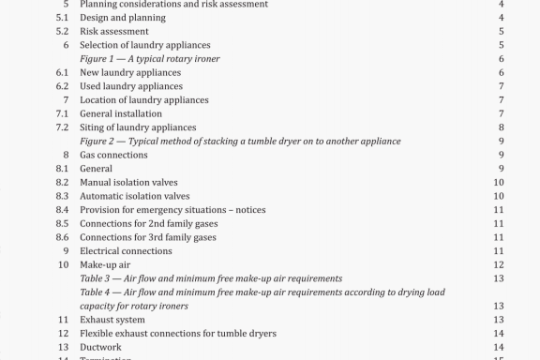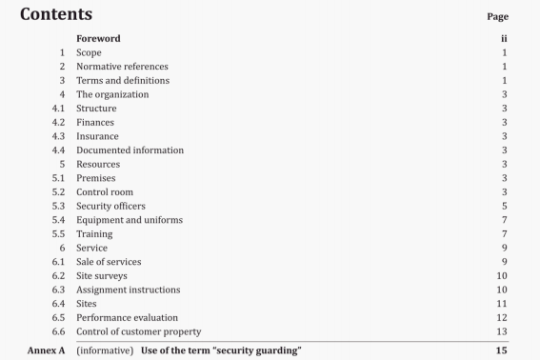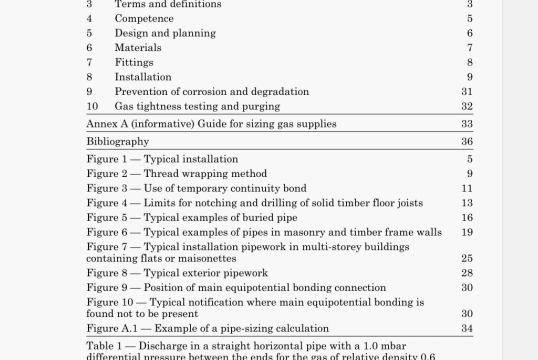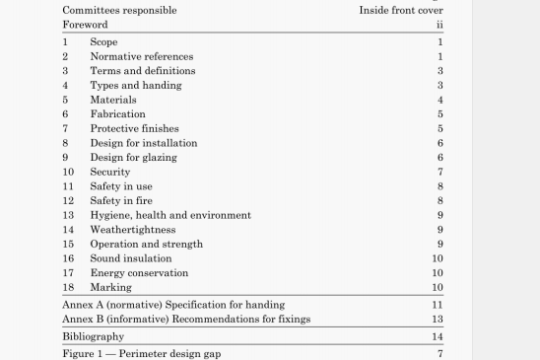BS 4873:2009 pdf download
BS 4873:2009 pdf download.Aluminium alloy windows anddoorsets – Specification.
5 Components
5.1 Aluminium extrusions and sheet products
Extruded aluminium profiles shall be fabricated from designated alloys 6060 or 6063 in tempers T4, T5 or T6 conforming to BS EN 755-9:2008 or BS EN 12020-2:2008.
When ancillary components such as sills, couplings etc. are formed from sheet materials they shall be fabricated from designated alloys 1200, 3103, 5005 or 5251 conforming to BS EN 485-2:2007 in temper suitable for the particular type of application and degree of forming to be adopted.
The aluminium profiles used in the construction of the frames excluding glazing beads, nibs, interlocks and similar features shall be not less than 1.2 mm thick.
NOTE This dimension takes into account any tolerances specified in the product standards or elsewhere.
The aluminium shall be finished by one of the following:
a) anodizing conforming to BS 3987 or BS EN 12373-1; b) a liquid organic coating conforming to BS 4842; c) a powder coating conforming to BS 6496 or BS EN 12206-1.
5.2 Frame joint sealing materials
When the completed window is tested in accordance with BS 6375-1 and BS 6375-2, there shall be no degradation of the sealing or the operational function of the window due to failure of the sealing materials.
NOTE Materials should be able to withstand stresses during assembly, transportation, installation and operation of the window.
5.3 Bearing devices and hardware
Metallic materials used for bearing devices and hardware shall have at least the equivalent corrosion resistance to BS EN 1670:2007, grade (class) 3 (96 h) when subjected to a neutral salt spray test as specified in BS EN ISO 9227. Tests shall be carried out on complete hardware items as supplied.
NOTE 1 For environments in very polluted localities such as those subject to combinations of industrial and coastal pollution, 85 EN 1670:2007, class 4 should be used.
NOTE 2 Requirements and test methods for hardware materials are specified in B5 EN 13126.
5.4 Weatherseals
Weatherseals shall be made of one of the following:
a) ethylene propylene diene monomer (epdm); or
b) plasticized PVC (PVC-P); or
c) polychloroprene (CR); or
d) polypropylene pile; or
e) sheathed cellular elastomeric polymer; or
f) silicone (Si); or
g) thermoplastic elastomer (TPE).
NOTE 1 Non-cellular forms of materials a), b) and c) are specified in BS 4255-1.
NOTE 2 85 EN 12365-1 gives performance requirements for weatherseals.
Glazing compounds shall be non-setting compounds, preformed mastic tapes, gun grade solvent release type sealants, one-part or two-part curing sealants or two-part rubberizing compounds. Gun grade sealants shall conform to BS ISO 11600.
5.5 Fixings
All straps, clips, brackets, lugs, and similar fixing devices and their attendant screws, bolts etc. shall be capable of meeting the applied wind and operational loads and shall achieve a minimum corrosion resistance of grade 3 (96 h) as specified in BS EN 1670:2007.
NOTE 1 Screws, nuts, bolts, rivets, metal washers, shims and other fixings should be tested in the “as used” condition.
NOTE 2 Spacer shims used at fixings, which serve only as packing and do not influence the structural integrity of the fixing, may be of extruded or moulded plastics material.
NOTE 3 Austenitic stainless steel is the preferred material for fixings subject to external forces and corrosive influences.
5.6 Glazing materials
Glass thickness and type shall be selected using the recommendations given in BS 6262-1, BS 6262-2, BS 6262-3, BS 6262-4 and/or BS 6262-7, as appropriate, to withstand the design wind pressure calculated in accordance with BS 6375-1 or BS 6399-2.
The exposed edges of glass adjustable louvre blades shall be arrised, ground or polished.
Insulating glass units shall conform to BS EN 1279.
6 Construction and design
NOTE The accessible parts of finished windows should as far as reasonably practicable be free from all sharp edges, burrs etc.
6.1 Work sizes
The work sizes for overall length and height shall be documented.
6.2 Manufacturing tolerances
The size of an assembled frame shall be within ±1.5 mm of the documented work size (6.1) in any dimension, and the difference between the diagonals of the assembled frame shall be not more than 4 mm.
6.3 Design for glazing
The frame design shall be such that:
a) the window can be glazed in accordance with BS 6262.




